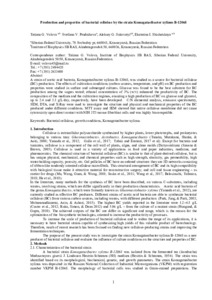Production and properties of bacterial cellulose by the strain Komagataeibacter xylinus B-12068
Скачать файл:
URI (для ссылок/цитирований):
https://link.springer.com/article/10.1007/s00253-018-9198-8https://elib.sfu-kras.ru/handle/2311/110944
Автор:
Волова, Т. Г.
Прудникова, С. В.
Суковатый, А. Г.
Шишацкая, Е. И.
Коллективный автор:
Институт фундаментальной биологии и биотехнологии
Институт цветных металлов и материаловедения
Кафедра медицинской биологии
Базовая кафедра биотехнологии
Кафедра инженерного бакалавриата CDIO
Дата:
2018-09Журнал:
Applied Microbiology and BiotechnologyКвартиль журнала в Scopus:
Q1Квартиль журнала в Web of Science:
Q2Библиографическое описание:
Волова, Т. Г. Production and properties of bacterial cellulose by the strain Komagataeibacter xylinus B-12068 [Текст] / Т. Г. Волова, С. В. Прудникова, А. Г. Суковатый, Е. И. Шишацкая // Applied Microbiology and Biotechnology. — 2018. — Т. 102 (№ 17). — С. 7417-7428Аннотация:
A strain of acetic acid bacteria, Komagataeibacter xylinus B-12068, was studied as a source for bacterial cellulose (BC) production. The effects of cultivation conditions (carbon sources, temperature, and pH) on BC production and properties were studied in surface and submerged cultures. Glucose was found to be the best substrate for BC production among the sugars tested; ethanol concentration of 3% (w/v) enhanced the productivity of BC. Optimization of medium and cultivation conditions ensures a high production of BC on glucose and glycerol, up to 2.4 and 3.3 g/L/day, respectively. C/N elemental analysis, emission spectrometry, SEM, DTA, and X-ray were used to investigate the structure and physical and mechanical properties of the BC produced under different conditions. MTT assay and SEM showed that native cellulose membrane did not cause cytotoxicity upon direct contact with NIH 3T3 mouse fibroblast cells and was highly biocompatible.

